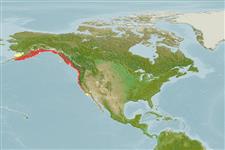Environment: milieu / climate zone / depth range / distribution range
Ecologie
marien; brak water benthopelagisch. Temperate; 61°N - 33°N, 163°W - 117°W
Eastern Pacific: Prince William Sound, Gulf of Alaska to Long Beach, southern California, USA. Reports from the western Pacific are misidentifications of Hypomesus japonicus.
Lengte bij maturiteit / Grootte / Gewicht / Leeftijd
Maturity: Lm ?, range 9 - ? cm
Max length : 30.5 cm TL mannelijk / geslacht onbekend; (Ref. 6885); common length : 15.0 cm TL mannelijk / geslacht onbekend; (Ref. 12193); max. gerapporteerde leeftijd: 5 Jaren (Ref. 72502)
Dorsale stekels (totaal): 0; Dorsale zachte stralen (totaal): 9-11; Anale stekels 0; Anale zachte stralen: 12 - 17; Wervels: 64 - 67. Vomer small, without posterior process; periphery of glossohyal bone with single row of blunt teeth, a few teeth located irregularly at center of distal region; base of adipose fin less than 20% of head length; eye small; adipose eyelid well developed (Ref. 33312). Distinguished by its midlateral scale count of 66 to 73 and the presence of 4 to 7 pyloric caeca (Ref. 27547). Lateral line short and incomplete, reaching about to tip of pectorals (Ref. 27547). Adipose sickle-shaped; pectorals small; pelvic fins originating behind or below dorsal origin (Ref. 6885). Light olive green to brownish on back, sides and belly silvery and iridescent with a bright reflecting band along the side in living specimens; males show more golden hues than females during spawning season (Ref. 6885). Branchiostegal rays: 7-8 (Ref. 35792).
Individuals 3.5 cm may ascend rivers, presumably returning to the sea shortly after (Ref. 27547). Presumably young move offshore and reappear inshore as mature adults (Ref. 27547). At sea, they feed on small crustaceans, worms and jellyfish, as well as larval fishes (Ref. 6885, 10276). Females reach age 3, males age 2 (Ref. 27547). Oviparous, with demersal eggs and planktonic larvae (Ref. 35792). Eggs are laid on beaches with heavy surf action (Ref. 33312).
Schools approach the beach to spawn, usually with the females appearing a few days before the males. At spawning, large numbers of males mill about near the edge of the surf. When a female is seen, numbers of males pursue her and try to get into spawning position. If she swims to deeper water, the males desert her. 1 to 5 males swim parallel to and slightly behind a ripe female. The males press against the female and as they reach water 2.5 to 5 cm deep, the fish bend and vibrate, releasing eggs and sperm, then retreat to deeper water. The spawning act may be repeated on several successive waves. Wave action buries the eggs, usually to a depth of 2.5 to10 cm but sometimes to as deep as 30 cm (Ref. 27547).
Saruwatari, T., J.A. López and T.W. Pietsch, 1997. A revision of the ormerid genus Hypomesus Gill (Teleostei: Salmoniformes), with a description of a new species from the southern Kuril Islands. Species Diversity 2:59-82. (Ref. 33312)
Status op de Rode Lijst van het IUCN (Ref. 130435)
Gevaar voor de mens
Harmless
Gebruik door de mens
Visserij: commercieel; sportvis: ja
Tools
Speciale rapporten
Download XML
Internetbronnen
Estimates based on models
Preferred temperature (Ref.
123201): 7.5 - 11.8, mean 8.6 °C (based on 58 cells).
Fylogenetische diversiteitsindex (Ref.
82804): PD
50 = 0.5313 [Uniqueness, from 0.5 = low to 2.0 = high].
Bayesian length-weight: a=0.00372 (0.00182 - 0.00758), b=3.17 (2.99 - 3.35), in cm total length, based on LWR estimates for this (Sub)family-body shape (Ref.
93245).
Trofisch niveau (Ref.
69278): 3.4 ±0.41 se; based on food items.
Weerstandsvermogen (Ref.
120179): Gemiddeld, minimale populatieverdubbelingstijd 1,4-4,4 jaar (tm=1-2; tmax=5; Fec=1,320).
Fishing Vulnerability (Ref.
59153): Low vulnerability (21 of 100).
Climate Vulnerability (Ref.
125649): High to very high vulnerability (71 of 100).
Nutrients (Ref.
124155): Calcium = 54.4 [24.8, 135.3] mg/100g; Iron = 0.415 [0.193, 1.044] mg/100g; Protein = 16.9 [13.6, 19.8] %; Omega3 = 0.633 [0.287, 1.428] g/100g; Selenium = 12.8 [5.8, 26.6] μg/100g; VitaminA = 29.8 [11.0, 84.9] μg/100g; Zinc = 0.771 [0.517, 1.176] mg/100g (wet weight); based on
nutrient studies.
